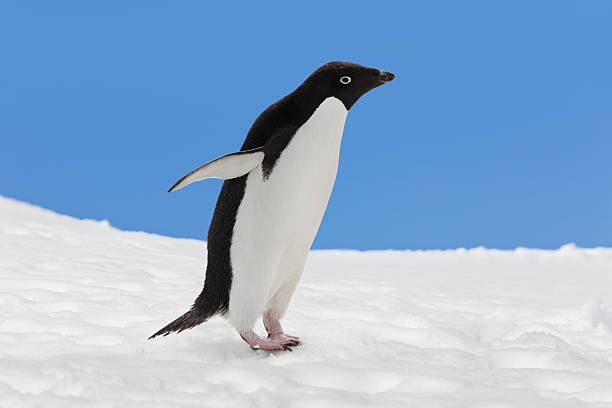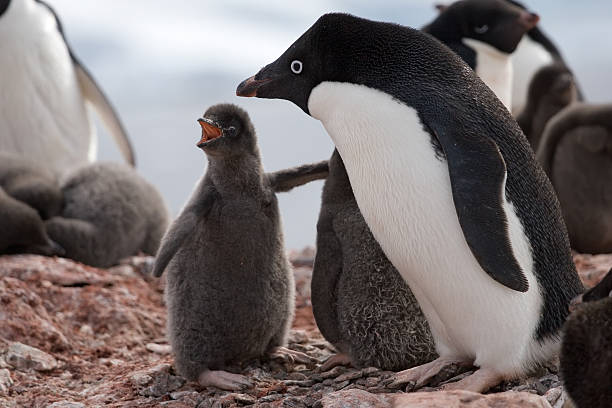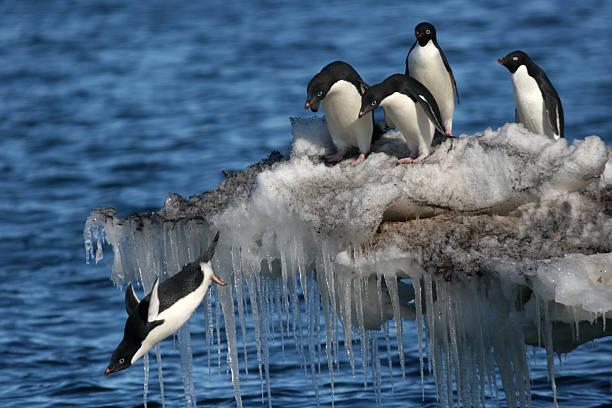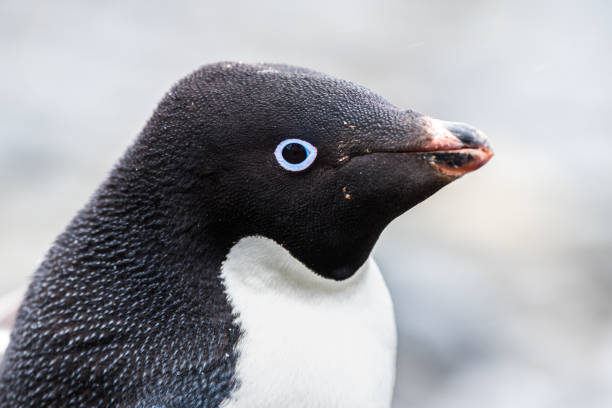Table of Contents
Scientific Classification
| Kingdom | Animalia |
| Phylum | Chordata |
| Class | Aves |
| Order | Sphenisciformes |
| Family | Spheniscidae |
| Genus | Pygoscelis |
| Species | Pygoscelis adeliae |
| Scientific Name | Pygoscelis adeliae |
Description
The Adelie Penguin (Pygoscelis adeliae) is a small, resilient seabird native to Antarctica. These penguins are easily recognized by their striking black-and-white plumage, resembling little tuxedos. Their black heads, backs, and tails contrast sharply with their white bellies, and a distinctive white ring encircles their eyes, giving them a very expressive appearance.
Well-suited to the extreme Antarctic environment, these penguins have streamlined bodies that enhance their swimming abilities. Their webbed feet and rigid flippers enable them to hunt swiftly beneath the water’s surface. On average, an Adelie Penguin measures about 46 to 71 cm (18 to 28 inches) in height and weighs between 3.6 to 6 kg (8 to 13 lbs).

Distribution
Adelie Penguins are found exclusively in the Southern Hemisphere, primarily along the coastlines of Antarctica. Their range includes:
The Ross Sea
The Weddell Sea
The Antarctic Peninsula
Several sub-Antarctic islands
They establish large breeding colonies on coastal land that is free of ice, typically in regions with pack ice.
Habitat
Adelie Penguins inhabit some of the most extreme environments on Earth. Their preferred habitats include:
- Coastal Antarctic regions – Where they breed and raise their chicks on rocky beaches.
- Sea ice zones – Used for hunting and resting.
- Ice-free islands – Where they establish large nesting colonies.
In winter, they move north. They follow the pack ice to find food-rich waters.
Diet
Adelie Penguins are carnivorous and primarily feed on marine organisms. Their diet mainly includes:
– Krill (Euphausia superba) – A key food source.
– Fish – Smaller species such as silverfish.
– Squid and other cephalopods – Consumed on occasion.
They dive into cold waters, using their strong flippers to swim quickly. Their sharp beaks are effective for catching prey.
Behavior
- Adelie Penguins display intriguing social and survival behaviors:
- Highly Social – They inhabit large colonies, collaborating to construct nests and nurture their chicks.
- Skilled Swimmers – Capable of diving as deep as 175 meters (574 feet) to hunt for food.
- Fierce Defenders – Recognized for their territorial nature during the breeding season.
- Migratory – They journey long distances in search of food as seasons change.
Lifespan
The average lifespan of an Adelie Penguin in the wild typically ranges from 10 to 20 years. Their survival rates are influenced by various factors, including food availability, climate conditions, and predation.
Reproduction and Lifecycle
Adelie Penguins breed during the Antarctic summer, which spans from October to February. Their reproductive cycle consists of the following stages:
Nesting – Males gather small stones to construct nests that will attract females.
Egg Laying – Females typically lay two eggs in November.
Incubation – Both parents share the responsibility of incubating the eggs for approximately 32 to 35 days.
Chick Rearing – Once the chicks hatch, they are fed regurgitated food by their parents.
Fledging – The young penguins gain independence at around 7 to 9 weeks of age.

Predators
Adelie Penguins swim well, but they face threats from various Antarctic predators:
- Leopard seals – Their primary natural predators in the water.
- Orcas (Killer Whales) – Occasionally hunt penguins.
- Skuas and Giant Petrels – Prey on eggs and young chicks.
Adelie Penguins escape predators by being agile in the water. They also find safety in large colonies on land.
Adaptations
To thrive in the challenging Antarctic environment, Adelie Penguins have evolved a number of adaptations:
Thick Layer of Blubber – Offers insulation against the frigid temperatures.
Dense Feathers – Waterproof and resistant to wind, perfect for extreme cold.
Salt Gland – Assists in eliminating excess salt from the seawater they consume.
Strong Beaks and Flippers – Enhance their abilities in hunting and swimming.
Camouflaging Colors – Their black backs blend with the ocean’s depths, helping them remain concealed from predators above.
Conservation Status
- Adelie Penguins are classified as Least Concern by the IUCN, with a stable population exceeding 10 million individuals. Nevertheless, their long-term survival is threatened by several factors:
- Threats:
- Climate Change – The melting of sea ice impacts krill populations, which are crucial to their diet.
- Human Activity – Fishing and pollution interfere with their natural habitat.
- Overfishing – This diminishes the availability of prey species, particularly krill.
Conservation Efforts:
- Protected Marine Areas – These areas have been set up to safeguard essential feeding and breeding habitats.
- Climate Change Mitigation – Scientists are investigating the impact of global warming on penguin populations to better understand their survival challenges.
- Reduced Human Impact – New regulations have been implemented to minimize tourism and fishing activities in the waters around Antarctica.
Conclusion
Adelie Penguins exemplify nature’s ability to adapt to harsh environments. Their robust social connections and survival strategies enable them to flourish. They are essential to the Antarctic ecosystem, highlighting the importance of their conservation. However, climate change poses a significant threat to their habitat. Continuous conservation initiatives are vital for the survival of this resilient seabird.



